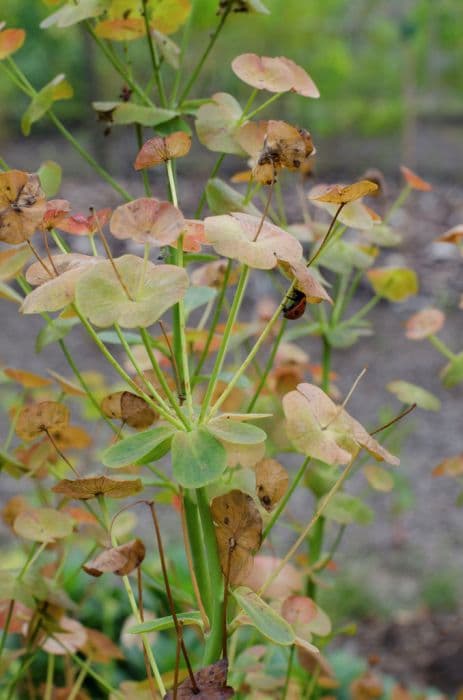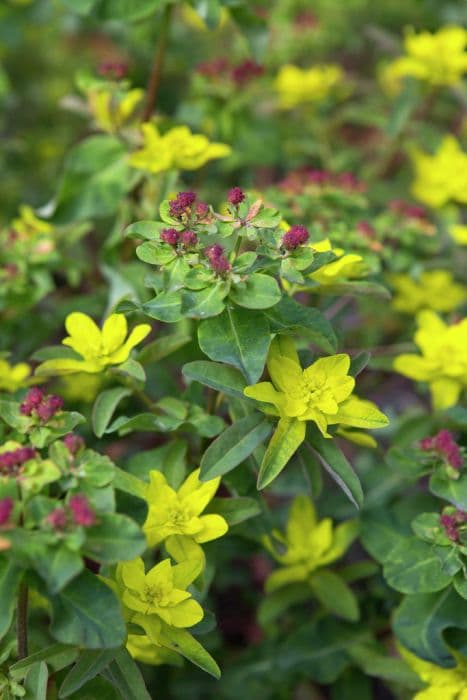Mediterranean Spurge Euphorbia characias 'Portuguese Velvet'

ABOUT
The Portuguese Velvet is a striking plant that features a lush, evergreen foliage which has a unique texture that is reminiscent of velvet, giving it its name. Its leaves are a deep green color with a grayish undertone and they often appear arranged in a tight spiral around the stem, creating an interesting architectural effect. During its blooming period, the Portuguese Velvet sports cylindrical flower heads which are a vibrant chartreuse hue. These flower clusters stand bold and bright against the softer texture of the leaves, attracting the eyes of onlookers as well as various pollinators. The overall aspect of this plant provides a dramatic visual impact with its contrasting leaf and flower colors, as well as its distinctive, velvety leaf surface.
About this plant
 Names
NamesFamily
Euphorbiaceae
Synonyms
Mediterranean Spurge, Albanian Spurge, Portuguese Velvet
Common names
Euphorbia characias
 Toxicity
ToxicityTo humans
Mediterranean Spurge, like all Euphorbias, contains a milky sap known as latex that is toxic to humans. This sap is a skin irritant and can cause a rash if it comes in contact with the skin. If the latex gets into the eyes, it can cause serious inflammation and temporary blindness. If ingested, the sap can cause irritation of the mouth, throat, and stomach, leading to nausea, vomiting, diarrhea, and in severe cases, it can be life-threatening. It is essential to handle Mediterranean Spurge with care and wash your hands thoroughly after handling it to avoid accidental ingestion or contact with mucous membranes.
To pets
Mediterranean Spurge is toxic to pets due to the latex it contains, similar to its effects on humans. If a pet chews or ingests any part of the plant, the latex can cause symptoms such as drooling, vomiting, diarrhea, and irritation of the mouth and gastrointestinal tract. In severe cases, ingestion can lead to more serious complications, including difficulty breathing and systemic effects. It is crucial to prevent pets from having access to this plant to avoid any potential poisoning incidents.
 Characteristics
CharacteristicsLife cycle
Perennials
Foliage type
Evergreen
Color of leaves
Bluish-green
Flower color
Yellow-green
Height
3-4 feet (90-120 cm)
Spread
2-3 feet (60-90 cm)
Plant type
Shrub
Hardiness zones
8
Native area
Mediterranean
Benefits
 General Benefits
General Benefits- Drought Tolerance: Euphorbia characias 'Portuguese Velvet' is highly drought-resistant, requiring minimal water once established, making it suitable for xeriscaping and arid gardens.
- Easy Maintenance: It is a low maintenance plant, requiring little care beyond occasional pruning to remove spent flowers and maintain shape.
- Architectural Structure: With its upright form and spikey texture, it adds architectural interest to garden designs.
- Long Blooming Season: Produces showy, long-lasting flowers that can bloom from early spring through summer, providing extended visual interest.
- Attracts Pollinators: The flowers attract bees and other pollinators, supporting the local ecosystem.
- Deer Resistant: The plant is not favored by deer, making it a good choice for gardens in areas with deer populations.
- Versatile Landscaping Use: Suitable for borders, rock gardens, coastal gardens, and as a focal point in mixed beds.
- Erosion Control: Its root system can help stabilize slopes and banks, reducing soil erosion.
- Seaside Suitable: The plant is salt-tolerant and can thrive in coastal conditions.
- Non-Invasive: It does not tend to spread aggressively, which reduces the risk of it taking over garden spaces.
 Medical Properties
Medical PropertiesThis plant is not used for medical purposes.
 Air-purifying Qualities
Air-purifying QualitiesThis plant is not specifically known for air purifying qualities.
 Other Uses
Other Uses- Decorative dried arrangements: The flowering stems of Euphorbia characias can be cut and dried to provide an interesting texture and shape for dried floral arrangements.
- Highlighting garden architecture: Leafy spires of the Euphorbia can add vertical interest to garden designs, especially when framed against walls or other architectural elements.
- Creating garden borders: The dense, bushy growth habit of Euphorbia characias makes it an excellent choice for creating crisp, structured borders along garden beds or pathways.
- Supporting beneficial insects: Euphorbia characias blooms are attractive to pollinators, such as bees, helping to increase the biodiversity of garden ecosystems.
- Accentuating rock gardens: With its drought tolerance and striking appearance, Euphorbia characias is well-suited for adding texture and color to rock gardens.
- Coastal landscaping: Being native to the Mediterranean, Euphorbia characias is salt-tolerant, making it ideal for seaside gardens where salty spray might harm other less hardy plants.
- Photography subjects: The unique form and texture of Euphorbia characias, especially when it's in bloom, can provide interesting subjects for botanical photography.
- Inspiring artists: The striking form, color, and texture variance of Euphorbia characias often serve as inspiration for painting, drawing, and other forms of visual art.
- Ecological education: Euphorbia characias can be used in educational settings to teach about Mediterranean ecosystems and plant adaptability to dry climates.
- Mulching material: When pruned, the stems and leaves of Euphorbia characias can be used as organic mulch, providing soil moisture retention and weed suppression.
Interesting Facts
 Feng Shui
Feng ShuiThe Mediterranean Spurge is not used in Feng Shui practice.
 Zodiac Sign Compitability
Zodiac Sign CompitabilityThe Mediterranean Spurge is not used in astrology practice.
 Plant Symbolism
Plant Symbolism- Resilience: Euphorbia characias 'Portuguese Velvet', commonly known as Mediterranean Spurge, often signifies resilience due to its ability to thrive in harsh, dry environments, symbolizing the capacity to endure and prosper through challenges.
- Protection: The milky sap of Mediterranean Spurge is toxic and can deter animals from eating the plant, which lends it the symbolic meaning of protection against harm and negative influences.
- Healing: Historically, some species of Euphorbia were used for medicinal purposes. This history imparts a symbolic association with healing and relief from physical or emotional pain.
- Persistence: With their persistent growing habit and long lifespan, these plants often represent tenacity and the drive to persist through difficulties.
 Water
WaterThe Mediterranean Spurge should be watered deeply but infrequently to mimic the natural conditions of its native habitat. During the growing season in spring and summer, water approximately once a week with about one gallon per plant, ensuring the soil is allowed to dry out between waterings. In the fall and winter, reduce watering to every other week or less, depending on rainfall and temperature, as the plant enters a dormant period. Overwatering can lead to root rot, so it is crucial to check the soil moisture before watering.
 Light
LightMediterranean Spurge thrives in full sunlight, making it ideal for a spot that receives at least six hours of direct sunlight daily. This plant can tolerate partial shade, but its best growth and flowering occur when it is planted in an area with plenty of sunshine. Avoid deep shade conditions as they can make the plant leggy and reduce flowering.
 Temperature
TemperatureMediterranean Spurge is well-suited for a range of temperatures and can withstand occasional drops down to about 30 degrees Fahrenheit. However, for optimal growth, maintain an environment where temperatures stay between 50 and 85 degrees Fahrenheit. The plant is drought-tolerant and can survive in higher temperatures as long as there is adequate airflow.
 Pruning
PruningPrune the Mediterranean Spurge in late winter or early spring to remove faded flowers and maintain the desired shape. Pruning stimulates new growth, which can lead to more vigorous plants and plentiful blooms in the following season. It is typically enough to prune this plant once a year, just before the onset of the growing season.
 Cleaning
CleaningAs needed
 Soil
SoilMediterranean Spurge prefers a well-drained soil mix with sand or grit to enhance drainage. The ideal soil pH is neutral to slightly alkaline, ranging from pH 6.5 to 7.5. Regular potting soil amended with perlite or pumice can work well.
 Repotting
RepottingMediterranean Spurge should be repotted every two to three years or when it outgrows its container. This helps to refresh the soil and ensure continued growth and health.
 Humidity & Misting
Humidity & MistingMediterranean Spurge thrives in average room humidity levels. It does not require high humidity and can tolerate dry air well, making it suitable for typical indoor environments.
 Suitable locations
Suitable locationsIndoor
Ensure bright light, minimal water, and well-drained soil.
Outdoor
Plant in full sun with well-drained soil; drought-tolerant.
Hardiness zone
8-11 USDA
 Life cycle
Life cycleEuphorbia characias 'Portuguese Velvet', commonly known as Mediterranean Spurge, begins its life cycle as a seed, which germinates in warm, well-drained soil, typically in spring. The seedling then develops into a small rosette of leaves at the soil surface. As the plant matures, it forms a bushy mound of woolly gray-green leaves, reaching up to 3 feet tall and wide. In late winter to early spring, the Mediterranean Spurge produces characteristic greenish-yellow flowers surrounded by showy, long-lasting bracts. After pollination, the plant produces seed capsules that burst open when ripe, dispersing seeds for the next generation. The plant may exhibit a perennial life cycle, living for several years, but in colder climates it may behave more like a biennial, requiring replanting or self-seeding to persist in the garden.
 Propogation
PropogationPropogation time
Spring to Early Summer
Propogation: Euphorbia characias 'Portuguese Velvet', commonly referred to as Mediterranean Spurge, is generally propagated through seed or stem cutting. The most popular method is stem cutting, which is commonly done during late spring or early summer when the plant's growth is most active. To propagate by this method, a healthy stem cutting about 4 to 6 inches (approximately 10 to 15 centimeters) long is taken with a clean, sharp knife. The cutting should include a couple of leaf nodes as these are the points from which roots will develop. The lower leaves are removed, and the cut end is allowed to dry out for a day to form a callus which helps to prevent rot. Then the cutting is placed in well-draining soil mix, watering sparingly until the roots develop. This can take a few weeks, during which the cutting should be kept in a warm, well-lit environment but out of direct sunlight to encourage root growth.

![Spurge [Silver Swan]](/_next/image?url=https%3A%2F%2Fplants-admin.emdemapps.com%2Fimages%2Fplants%2F%2Fimages%2F604b573f6c8f6.png&w=640&q=75)







